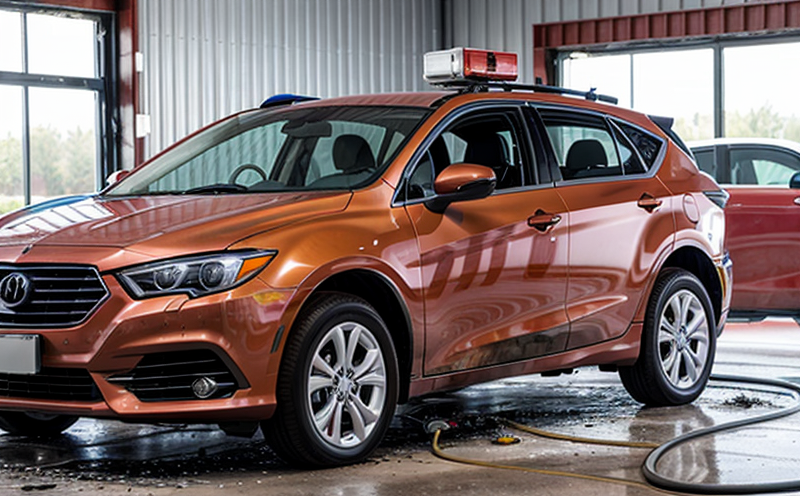Fire Resistance Testing of Headrest Components
The fire resistance testing of headrest components is a critical aspect of ensuring automotive safety and compliance with international standards. Automotive manufacturers are increasingly focusing on improving vehicle interiors to enhance passenger comfort while maintaining structural integrity during emergencies. A headrest, being an integral part of the seating system, plays a vital role in protecting passengers from injury by absorbing impacts during collisions.
The fire resistance test evaluates how well a headrest component can withstand exposure to flame and resist ignition or propagation of fire. This testing is essential for ensuring that headrests do not contribute to the spread of fire within the vehicle cabin, thus safeguarding passenger safety. Failure in this area can lead to significant risks during accidents.
Compliance with international standards such as ISO 12236 and ASTM E84 ensures that manufacturers meet regulatory requirements. These tests are conducted under controlled conditions to simulate real-world scenarios where fire might occur within a vehicle. The testing process involves exposing the headrest component to a flame source for a specified duration while monitoring various parameters like flame spread, smoke production, and heat release.
The results of this test provide critical insights into the performance of headrest components under fire exposure. By adhering to these tests, manufacturers can ensure that their products meet stringent safety standards, thereby protecting passengers during emergencies. This testing is not only crucial for compliance but also enhances brand reputation and consumer trust.
The test setup typically includes a specialized chamber designed to simulate the environment in which a headrest might encounter fire. The specimen (headrest component) is positioned within this chamber and exposed to a controlled flame source according to predefined parameters. Sensors and cameras are used to monitor the behavior of the specimen, capturing data on its resistance to ignition and ability to self-extinguish.
The results from these tests guide manufacturers in making informed decisions about material selection, design optimization, and manufacturing processes. By incorporating the insights gained from fire resistance testing, automotive manufacturers can develop safer headrest components that contribute significantly to overall vehicle safety.
Why It Matters
The importance of fire resistance testing for headrest components cannot be overstated. In the event of a vehicle fire, the structural integrity and material properties of headrests can play a critical role in protecting passengers from severe injuries or fatalities. Ensuring that these components do not contribute to the spread of fire is paramount.
- Reduces the risk of injury during fires
- Avoids potential structural failures within the vehicle cabin
- Promotes compliance with safety standards and regulations
- Enhances overall passenger safety in emergency situations
The fire resistance testing process is designed to replicate real-world conditions, providing manufacturers with reliable data that can be used to improve product design. By incorporating the results of these tests into their development processes, automotive manufacturers can ensure that headrest components meet or exceed industry standards and contribute positively to overall vehicle safety.
Scope and Methodology
| Parameter | Description |
|---|---|
| Test Specimen | The headrest component to be tested, including any relevant materials and designs. |
| Flame Source | A controlled flame source that simulates the conditions of a vehicle fire. |
| Exposure Time | The duration for which the specimen is exposed to the flame, typically ranging from 5 to 20 minutes depending on standards. |
| Sensor Placement | Placement of sensors to monitor temperature and smoke production during testing. |
The methodology for fire resistance testing is standardized according to international guidelines such as ISO 12236. These standards provide precise protocols for conducting the test, ensuring consistency across different laboratories. The process involves exposing the headrest component to a controlled flame source and monitoring its behavior over time. Key parameters include the duration of exposure, temperature rise, and smoke generation.
Once the specimen has been exposed to the flame according to specified standards, it is evaluated for several critical factors:
- Resistance to ignition
- Flame spread characteristics
- Smoke production levels
- Heat release rate
The results from these tests provide comprehensive insights into the fire resistance performance of headrest components. This information is invaluable for manufacturers, as it allows them to make informed decisions about material selection and design improvements.
Why Choose This Test
- Ensures compliance with international safety standards
- Enhances passenger safety during vehicle fires
- Provides reliable data for product development and improvement
- Promotes brand reputation through adherence to regulatory requirements
Selecting the fire resistance testing of headrest components is a strategic decision that aligns with broader quality assurance initiatives. By choosing this test, manufacturers can demonstrate their commitment to passenger safety and compliance with industry best practices.





